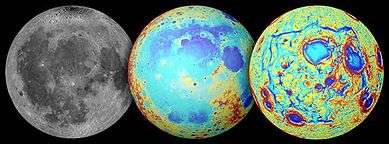Oceanus Procellarum
|
Oceanus Procellarum is the large mare in the center and upper left of this image. | |
| Coordinates | 18°24′N 57°24′W / 18.4°N 57.4°WCoordinates: 18°24′N 57°24′W / 18.4°N 57.4°W |
|---|---|
| Diameter | 2,592 km (1,611 mi)[1] |
| Eponym | Ocean of Storms |
Oceanus Procellarum (/oʊˈsiːənəs ˌprɒsᵻˈlɛərəm/; Latin for "Ocean of Storms") is a vast lunar mare on the western edge of the near side of the Moon. It is the only one of the lunar maria to be called an "Oceanus" (ocean), due to its size: Oceanus Procellarum is the largest of the maria, stretching more than 2,500 km (1,600 mi) across its north-south axis and covering roughly 4,000,000 km2 (1,500,000 sq mi).
Characteristics
Like all lunar maria, Oceanus Procellarum was formed by ancient basaltic flood volcanic eruptions that covered the region in a thick, nearly flat layer of solidified magma. Unlike the other lunar maria, however, Oceanus Procellarum may or may not be contained within a single well-defined impact basin. Around its edges lie many minor bays and seas, including Mare Nubium and Mare Humorum to the south. To the northeast, Oceanus Procellarum is separated from Mare Imbrium by the Carpathian Mountains. On its north-west edge lies the 32 km wide Aristarchus ray crater, which is considered as the brightest feature on the Near side of the Moon.[2] Also, the more-prominent ray-crater Copernicus lies within the eastern edge of the mare, distinctly with its bright ray materials sprawling over the darker material. On the northern edge of Oceanus Procellarum lies Sinus Roris.
Origin

There are several hypotheses about the origin of Oceanus Procellarum and a related asymmetry between the near and far sides of the Moon. One of the most likely is that Procellarum was a result of an ancient giant impact on the near side of the Moon. The size of the impact basin has been estimated to be more than 3,000 kilometers, which would make it one of the largest craters in the Solar System.

The impact likely happened very early in the Moon's history: at the time when magma ocean still existed or just ceased to exist. It deposited 5–30 km of crustal material on the far side forming highlands. If this is the case, all impact related structures such as crater rim, central peak etc. have been obliterated by later impacts and volcanism. One piece of evidence in support of this hypothesis is concentration of incompatible elements (KREEP) and low calcium pyroxene around Oceanus Procellarum.[3][4]
Procellarum may have also been formed by spatially inhomogeneous heating during the Moon's formation.[3] The GRAIL mission, which mapped the gravity gradients of the moon, found square formations resembling rift valleys surrounding the region beneath the lava plains, suggesting the basin was formed by heating and cooling of the lunar surface by internal processes rather than by an impact, which would have left a round crater.[5]
Other hypotheses include a late accretion of a companion Moon on the far side. The latter postulates that in addition to the present Moon, another smaller (about 1,200 km in diameter) moon was formed from debris of the giant impact. After a few tens of millions of years it collided with the Moon and due to a small collisional velocity simply piled up on one side of the Moon forming what is now known as far side highlands.[6]
Exploration
The robotic lunar probes Luna 9, Luna 13, Surveyor 1 and Surveyor 3 landed in Oceanus Procellarum. Luna 9 landed southwest of Galilaei crater in 1966. Luna 13 landed southeast of Seleucus crater, later in 1966. Surveyor 1 landed north of Flamsteed crater (within the larger Flamsteed P) in 1966, and Surveyor 3 landed in 1967. The manned Apollo 12 mission also landed in Oceanus Procellarum, with astronauts Pete Conrad and Alan Bean on board. Their landing site, within 300m of Surveyor 3, has become known as Mare Cognitum.
References
| Wikimedia Commons has media related to Oceanus Procellarum. |
- ↑ "Oceanus Procellarum". Gazetteer of Planetary Nomenclature. USGS Astrogeology. Retrieved 2010-08-23.
- ↑ DK Space Encyclopedia: The Near Side of the Moon
- 1 2 Nakamura, R.; Yamamoto, S.; Matsunaga, T.; Ishihara, Y.; Morota, T.; Hiroi, T.; Takeda, H.; Ogawa, Y.; Yokota, Y.; Hirata, N.; Ohtake, M.; Saiki, K. (2012). "Compositional evidence for an impact origin of the Moon's Procellarum basin". Nature Geoscience. 5 (11): 775. doi:10.1038/NGEO1614.
- ↑ Byrne, C. J. (2008). "A Large Basin on the Near Side of the Moon". Earth, Moon, and Planets. 101 (3–4): 153–188. Bibcode:2007EM&P..101..153B. doi:10.1007/s11038-007-9225-8.
- ↑ "NASA Mission Points to Origin of "Ocean of Storms" on Earth's Moon" (Press release). NASA. 2014-10-01. Retrieved 2014-10-02.
- ↑ Jutzi, M.; Asphaug, E. (2011). "Forming the lunar farside highlands by accretion of a companion moon". Nature. 476 (7358): 69–72. doi:10.1038/nature10289. PMID 21814278.



